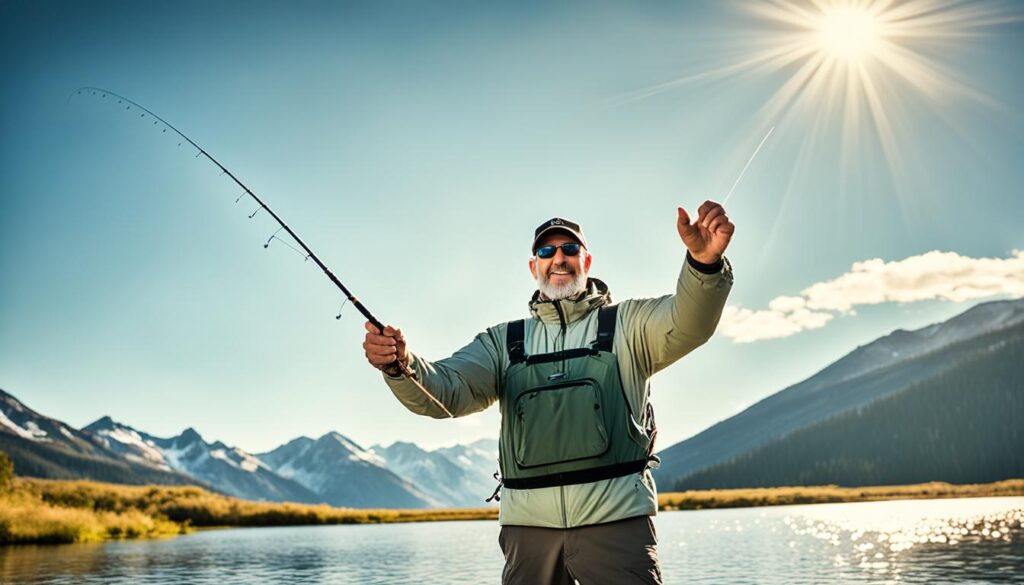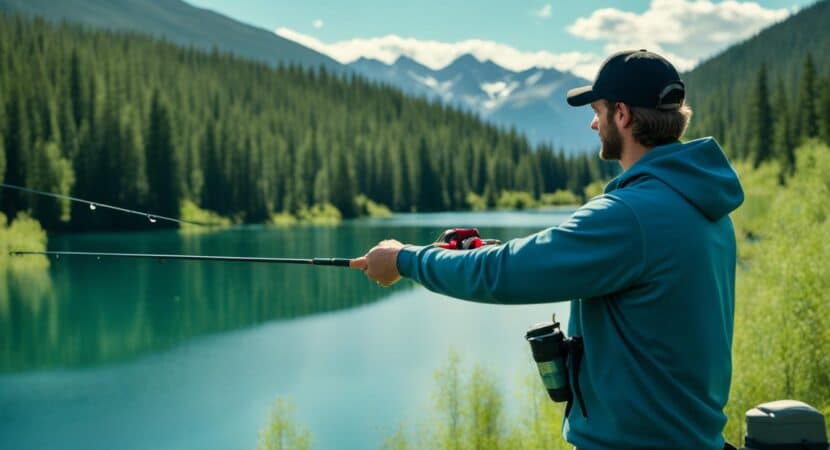Welcome to the enchanting world of fishing, where new adventures await with every cast. If you’ve ever wanted to learn to fish, you’re in the right place. Fishing is not just about the catch; it’s about connecting with nature, mastering patience, and enjoying the tranquility of the outdoors. Our beginner fishing guide is here to help you start fishing with ease and confidence. Packed with practical fishing tips for beginners and essential angling basics, this comprehensive tutorial will set you on course for your very first angling journey. So grab your tackle, and let’s dive into the gratifying world of fishing.
Contents
Key Takeaways
- Discover simple techniques and tips that make it easy for any novice to start fishing.
- Learn about the essential gear you need to embark on your first angling adventure.
- Understand the beauty and benefits of fishing, beyond just the thrill of the catch.
- Gain the knowledge to tackle fishing licenses and regulations like a pro.
- Uncover the basic angling skills that will help you reel in that first big catch.
- Explore various environments and find the perfect spot to cast your line.
Understanding the Basics of Fishing
Embarking on the rewarding journey of fishing begins with acquiring the necessary knowledge and equipment. This essential step enables those new to the sport to set off with confidence, ensuring they are well-prepared to enjoy this timeless recreational activity. We will cover the vital aspects of selecting the right fishing gear for beginners, identifying the various types of freshwater fish, and navigating through fishing license information and fishing regulations.
Choosing the Right Equipment
For those just starting out, choosing the appropriate fishing gear can make all the difference. It’s important to find equipment that is not only affordable but also easy to handle and suitable for targeted fish species. Let’s delve into the four cornerstones: rods, reels, lines, and hooks that make up the foundation of a beginner’s fishing kit.
Understanding Different Types of Fish
Recognizing the types of freshwater fish you’re likely to encounter is another critical piece of the puzzle. Each species of fish may require different techniques and lures to catch successfully. From bass and trout to catfish and pike, gaining knowledge about these species will enhance your fishing experiences and success rates.
Deciphering Fishing Licenses and Regulations
Being aware of fishing license information and fishing regulations is essential in maintaining the health of fisheries and ensuring the sustainability of fish populations. Licenses are a legal requirement in most locales and serve as a contribution to conservation efforts. Regulations can vary greatly depending on the region and the species, covering aspects such as size limits, bag limits, and specific fishing seasons.
| Fish Species | Preferred Habitat | Recommended Gear | Regulatory Considerations |
|---|---|---|---|
| Bass | Lakes and rivers with structured cover | Medium action rod, baitcasting reel, monofilament line | Possession limits, size restrictions |
| Trout | Cold, oxygen-rich streams and lakes | Light action rod, spinning reel, fluorocarbon line | Varies by species, often more restrictive |
| Catfish | Deep, slow-moving waters with soft bottoms | Heavy action rod, baitcasting reel, braided line | Some night fishing limitations may apply |
| Pike | Weedy, shallow bays of lakes and rivers | Medium-heavy action rod, spinner reel, wire leader | Seasonal restrictions in certain areas |
The Ideal Spots for a Successful Fishing Trip
For those eager to embrace the art of angling, selecting the optimal fishing hot spots is a crucial element that can determine the day’s success. Critical factors such as the natural features of fishing environments and the understanding of fish behavior in relation to weather become invaluable knowledge for both novice and experienced fishermen alike.
Types of Fishing Environments
When it comes to fishing environment selection, each type offers its distinct allure and challenges. Lakes often present placid expanses ideal for beginners. Rivers and streams challenge one’s skill with their swift currents and rich ecosystems. Ponds provide a more intimate setting, often teeming with a variety of species. Meanwhile, coastal areas call for an understanding of the tides and the vast array of saltwater dwellers they harbor. Grasping the complexities of these environments can lead to the successful capture of their aquatic residents.
How Weather Affects Fish Behavior
The correlation between fish behavior and weather is a subject of perpetual fascination. Fish are exceptionally sensitive to changes in barometric pressure, temperature swings, and frontal systems. For instance, an approaching storm could induce active feeding, while a sharp drop in temperature might send fish to deeper, more stable thermal layers. Anglers must be acutely attuned to these weather-induced behaviors to optimize their efforts and determine where to fish with the greatest potential yield.
Scouting the Perfect Fishing Location
Scouting entails more than a casual glance at the water’s surface; it’s an exploration into the aquatic realm to uncover the gathering points of fish. Forage locations rich in nutrients, strategic water depths, and the understanding of fish migration patterns can assist anglers in pinpointing where the next big catch may be lurking. Fishing hot spots are often discovered by piecing together these natural clues which paint a picture of underwater life.

Enhance your scouting precision and success with the table below:
| Environment Type | Features to Look For | Species Commonly Found |
|---|---|---|
| Lakes | Undisturbed coves, submerged structures | Largemouth Bass, Bluegill, Crappie |
| Rivers & Streams | Riffles, deep pools, eddies | Trout, Salmon, Smallmouth Bass |
| Ponds | Lily pads, driftwood, docks | Catfish, Perch, Sunfish |
| Coastal Areas | Sandbars, rock formations, tidal pools | Sea Bass, Flounder, Mackerel |
By integrating all these aspects—from the initial fishing environment selection to analyzing fish behavior with the weather and scouting your ultimate spot—the journey towards your successful fishing trip can become a reality with practice and persistence.
Bait and Lure Selection: What Draws Fish
When it comes to angling success, nothing is quite as pivotal as the use of the right bait to catch fish. Understanding the intricacies of choosing fishing lures and other forms of bait that can effectively attract fish is essential for both novice and seasoned anglers. Whether you’re seeking the best bait for fishing in a still lake or a flowing river, the key lies in mimicking the natural food sources in the habitat of your targeted species.
Live bait, such as worms, minnows, and crickets, offer irresistible movements and scents that often lead to successful catches. On the flip side, artificial lures—spinners, jigs, and plugs—appeal to the fish’s sense of sight and sound, proving effective in a variety of conditions. This guide breaks down these options to help you make an informed decision for your next fishing trip.
The following table provides insights into the effectiveness of various baits and lures for different types of fish in varying fishing environments:
| Fish Type | Best Live Bait | Effective Artificial Lures | Environment Specifics |
|---|---|---|---|
| Bass | Minnows, Worms | Crankbaits, Spinners | Clear waters with structures |
| Trout | Crickets, Mealworms | Spoons, Swimbaits | Fast-flowing streams |
| Catfish | Cut Bait, Chicken Liver | Soft Plastic Lures, Jigs | Murky, slow-moving waters |
| Walleye | Leeches, Minnows | Jerkbaits, Jig and Minnow | Deep, clear lakes |
Choosing between live bait and artificial lures often depends on the behavior of the fish you’re targeting. Live bait is a go-to option for its life-like appeal, offering texture and scent that can trigger a fish’s predator instinct. However, lures can be equally effective when used in the right manner. For example, when fish are aggressive, a quickly retrieved spinner might elicit a strike faster than live bait. It’s vital to evaluate factors like weather, water clarity, and fish activity levels when choosing fishing lures to ensure the best outcome.
Remember, fishing is an art—one that requires adapting to the environment and the behavior of your quarry. As you accumulate experience on the water, you’ll develop a sixth sense for what works best: whether that’s whip-smart artificial lures or the undeniable allure of live bait.
Tactical Fishing Techniques for Beginners
Fishing can be as simple or as complex as you make it, with a variety of tactics and methods at your disposal. Novice anglers can quickly improve their angling skills with knowledge of basic fishing techniques, such as casting methods, tying fishing knots, and proper rod handling. Below we delve into these fundamental practices to help you establish a strong foundation in your fishing pursuits.
Fishing Knots and How to Tie Them
Securely attaching your tackle to the fishing line is paramount, and learning a few essential fishing knots can make a significant difference. Common knots that every angler should master include the Palomar Knot, ideal for hooks and lures, and the Double Surgeon’s Knot, perfect for joining two lines. Properly tied knots ensure that your setup stays intact during the critical moment when landing a fish.
Steps to Tie the Palomar Knot:
- Double about 6 inches of line and pass the loop through the eye of the fishing hook.
- Tie a simple overhand knot with the doubled line, leaving a loop large enough for the hook to pass through it.
- Pass the hook through the loop, then pull the line while holding the hook to tighten the knot.
- Trim excess line from the free end to complete the knot.
Casting Methods for Maximum Reach
Casting your line with precision and distance can vastly increase your chances of a catch. Beginners should focus on mastering a basic overhead cast before moving on to other casting techniques. The key to an effective cast is smooth, fluid motion and correct timing of the release.
Essential Steps for the Overhead Cast:
- Start with the rod tip behind you at about a 2 o’clock position.
- Swiftly bring the rod forward to a 10 o’clock position.
- Release the line from your finger at the moment the rod passes the vertical plane.
- Follow through as the lure travels towards your target area.

Handling the Rod for a Better Technique
Good rod handling is crucial for maintaining control throughout the cast and when reeling in your catch. Grip the handle firmly, but not too tightly, and ensure your hands are positioned to maximize leverage and sensitivity.
Guidelines for Improved Rod Handling:
- Hold the rod with your dominant hand just above the reel.
- Place your other hand on the butt of the rod for increased stability and power.
- Keep your wrists flexible to absorb the energy of a fighting fish.
- Maintain constant awareness of the rod’s position to detect any subtle bites.
With consistent practice using these proven basic fishing techniques, your confidence and proficiency with rod, reel, and line will grow—setting you on the path to becoming an adept angler poised for many successful fishing adventures.
How to Catch Fish for Beginners
Embarking on the journey of fishing can be thrilling, and for those starting out, understanding the basics is key. Factors such as the best time to fish, environmental nuances, and maintaining a calm demeanor are pivotal. This section offers beginner fishing strategies that shed light on the importance of timing, water dynamics, and the virtue of patience, ensuring that newcomers can approach the task with greater confidence and skill.
Timing Your Fishing Trip
When planning to hit the waters, knowing the best time to fish is invaluable. The early morning hours or the periods just before dusk are often ideal, taking advantage of when fish are most active. Tides and spawning cycles also play a crucial role; for instance, fishing during high tide can increase chances of a good catch in coastal areas. In freshwater settings, consider the spawning seasons when fish move more predictably. Factor in these timings to optimize your outings and align with the fishes’ feeding habits.
Reading Water Currents and Structures
An angler’s ability to succeed is often tied to their skill in reading the water. Currents can dictate where fish are feeding or resting, while underwater structures such as weed beds, submerged logs, and drop-offs are prime spots for fish to congregate. Identifying these natural fish habitats allows you to cast your line more effectively. Aim to understand the aquatic environment—this awareness can be a game-changer in catching fish consistently.
Patience and Persistence: Keeping Your Cool
Perhaps the greatest challenge in fishing isn’t the act itself but maintaining fishing patience and persistence. Fishing requires a composed mind, especially during the inevitable slow periods waiting for bites. By maintaining a tranquil and resolved mindset, you reinforce your beginner fishing strategies and enhance the overall experience. Patience lets you stay focused and ready to act when the opportunity finally bites—embrace the journey and cherish the small moments of tranquility between the thrills.


Reply